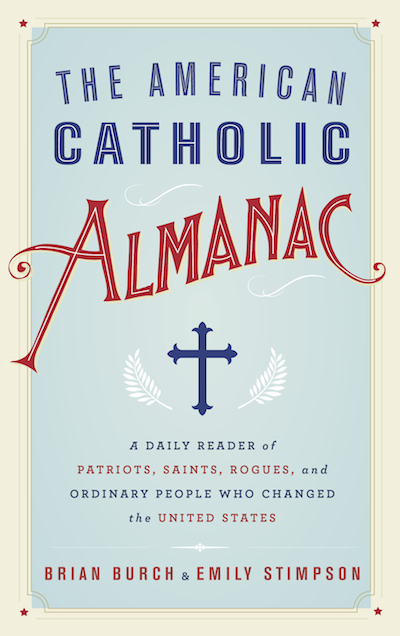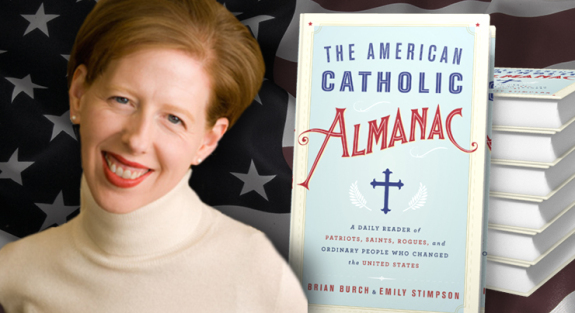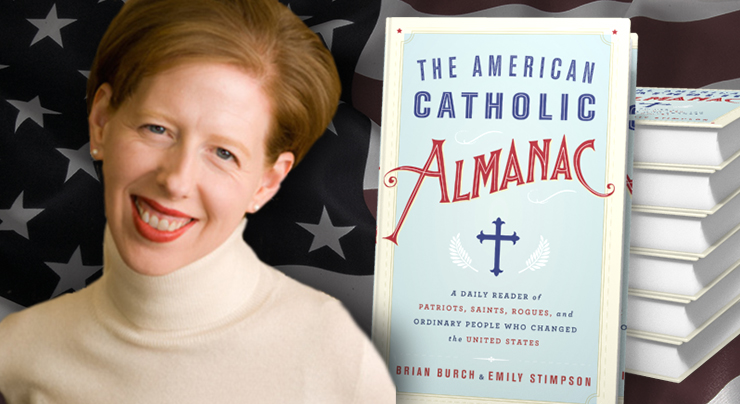Few writers know the American Catholic Church scene better than Emily Stimpson. As a longtime journalist for the Our Sunday Visitor Newsweekly and several other Catholic publications, she’s written hundreds of articles on American parishes, religious trends, and on-the-ground Catholic life.
That made her the perfect writer to pair with Catholic Vote’s Brian Burch to produce The American Catholic Almanac: A Daily Reader of Patriots, Saints, Rogues, and Ordinary People Who Changed the United States (Image Books, 2014).
I recently sat down with Emily to discuss the new book, the legacy of American Catholics, and which Catholics will be remembered by future historians.
BRANDON: What gave you and Brian Burch the idea for this book? Why this book at this time?
EMILY STIMPSON: In the wake of the HHS Mandate and recent court rulings on same-sex marriage, many Catholics were justifiably concerned about government-imposed limitations of their religious freedom. But many more Catholics didn’t seem concerned at all. There was a lot of shoulder shrugging. On top of that, more and more Americans have been questioning the Church’s place in the public square, seeing the Church (and faith itself) as a threat to democracy. Part of that problem, we believe, stems from a sort of historical amnesia. As American Catholics, we’ve forgotten our story: why our ancestors came here, how they sacrificed to establish the Catholic Church in America, and how much they contributed to the growth of this country. The hope was that by re-telling our family story—in a fun, interesting, and accessible way—we could help Catholics (and all people of good will) both appreciate what the Church has done and work more vigorously to protect it.
BRANDON: The Almanac includes 365 stories celebrating American men and women who have been shaped by their Catholic faith. What were some of the most intriguing stories you uncovered?
EMILY: Every day I spent writing this book I discovered intriguing characters and events. For example, did you know that the first Catholic seminary in the U.S. was housed in a former tavern? Knowing that puts a whole different spin on “theology on tap,” doesn’t it? There really is nothing new under the sun!
Other favorite discoveries included Stagecoach Mary, a gun-toting, cigar-smoking former slave who helped the Ursuline Sisters found a school and convent in the Wild West; Father George Alleman, one of the early missionaries in the Midwest who bears a striking resemblance to the mythical Paul Bunyon—they say his stride could match that of any horse’s; Sacramento’s first bishop, Patrick Manogue, an Irish-immigrant who used the fortune he made in the California Gold Rush to pay his way through seminary; and then all the fascinating converts, such as Fanny Allen (daughter of Revolutionary War hero Ethan Allen), Joseph Revere (Paul Revere’s grandson), and Levi Silliman Ives (the first Protestant bishop to become Catholic since the mid-seventeenth century). Really, I have too many favorites to list!
BRANDON: Suppose you had to choose one figure who best embodied the character of American Catholicism. Who would it be and why?
EMILY: It’s not possible. The shape of the Church in America today was formed by so many different ideas, struggles, and characters. As a Church, we are who we are today because of sinners like John F. Kennedy and saints like Elizabeth Ann Seton, missionaries like Father Frederick Farmer and mothers like Dorothy Day, converts like James Kent Stone and reverts like Jack Kerouac, not to mention immigrants from every corner of the globe and every class and station in life. These men and women became involved in heresies and rebellions, art and politics, ministry and industry. They followed different paths in pursuit of different ends. Sure, there are threads common to some of our spiritual ancestors, but not to all. It took many different strands of faith to weave together the Church we are today. And that was really one of the greatest lessons I took away from writing the book: seeing how rich and varied our history as American Catholics was.
BRANDON: What are some key lessons Catholics today should take away from these men and women who built the Church in America?
 EMILY: Probably the most important lesson is that the Faith should never be taken for granted. Yes, Christ promised that the gates of Hell would not prevail against the Church. But that doesn’t mean the Holy Spirit is going to do all the work for us. The health and vitality of the Church in any given place and time, in large part, depends upon her people. It depends upon us—working, praying, and sacrificing to hand on the Faith to the next generation. The Church did not spring up from American soil like Athena did from the head of Zeus, fully and perfectly formed. Rather, the Church in America was built on the blood of our own martyrs—Father Juan Padilla, Saint Isaac Jogues, and Father Pedro de Corpa, to name a few—as well as the ashes of churches, convents, and schools burned by anti-Catholic Nativists and Know-Nothings. We owe previous generations of Catholics a debt that can be repaid only by working just as hard as they did to form a new generation of disciples.
EMILY: Probably the most important lesson is that the Faith should never be taken for granted. Yes, Christ promised that the gates of Hell would not prevail against the Church. But that doesn’t mean the Holy Spirit is going to do all the work for us. The health and vitality of the Church in any given place and time, in large part, depends upon her people. It depends upon us—working, praying, and sacrificing to hand on the Faith to the next generation. The Church did not spring up from American soil like Athena did from the head of Zeus, fully and perfectly formed. Rather, the Church in America was built on the blood of our own martyrs—Father Juan Padilla, Saint Isaac Jogues, and Father Pedro de Corpa, to name a few—as well as the ashes of churches, convents, and schools burned by anti-Catholic Nativists and Know-Nothings. We owe previous generations of Catholics a debt that can be repaid only by working just as hard as they did to form a new generation of disciples.
Another lesson, which is a close second to the first, is that we have so much reason for hope. When we look at the rapid secularization of our culture, the unbelief and doubt among baptized Catholics, and the mounting persecution the Church in America faces from the government, it’s easy to despair. But really, so many of the struggles we face right now pale in comparison to the struggles early American Catholics faced. Priests today feel like they have their hands full when they’re put in charge of two parishes. But imagine being the only priest in a territory the size of Italy….or California. Fortunately, our bishops aren’t yet being shouted out of the pulpit by their priests during Mass, as John Carroll was in New York in the 1780s, and our priests aren’t being tarred and feathered like Father John Bapst was in 1850s Maine. There are no massive crowds of rioters standing outside our convents and parishes, preparing to torch buildings to the ground (as there was in Kentucky, Massachusetts, New York, Pennsylvania, Arkansas, and elsewhere in the mid-nineteenth century) nor is anyone threatening to close down Catholic schools for good (like Oregon State attempted to do in the 1920s). The Church in America has faced incredible persecution before, and not only survived, but thrived. I have great hope that, if we’re faithful, by God’s grace that will continue to hold true.
BRANDON: In a hundred years, when historians looks back on our era, which Catholics living today will have left an indelible mark on our country?
EMILY: Well, some actually made it into the book. Mother Angelica, the founder of EWTN was one. Father Michael Scanlan, TOR, president emeritus of Franciscan University was another. To that list, I’d also add Dr. Scott Hahn and Father Benedict Groeschel, CFR. Unfortunately, not all “indelible marks” are good marks, so there are some decided “Catholic rogues” leaving their mark on the country right now that would earn themselves a spot—Speaker Nancy Pelosi, Vice President Joe Biden, and Justice Anthony Kennedy leap immediately to mind. Bishops are a tougher call—I’m not willing to put any of our living bishops in the saints or rogues category just yet…although that’s not to say I don’t have my suspicions about where some of them will end up.
I should add, however, that “indelible mark” is a pretty high bar. The Almanac also includes more ordinary Catholics like the journalist Katharine Burton or NASA Flight Director Gene Kranz. History, for good and bad, isn’t only shaped by the greats. It’s also shaped by ordinary men and women like you and me, who choose whether or not they’re going to be faithful to God’s call and God’s law. It’s the ordinary folks, who either cooperate with grace or refuse grace, that ultimately move both Church and country in a given direction. So, in a sense, there’s not a Catholic among us who couldn’t find themselves in some future version of the Almanac. It all depends on how well we play the part God has given us to play.



